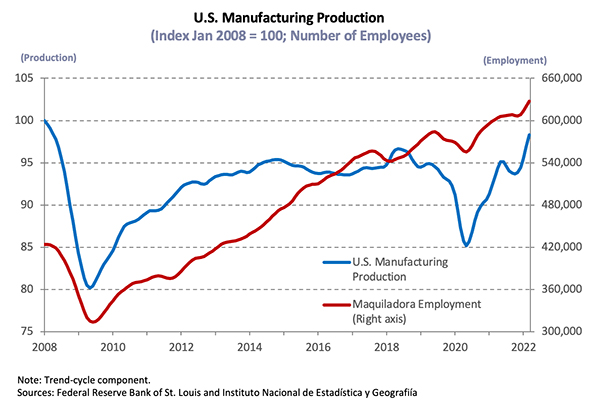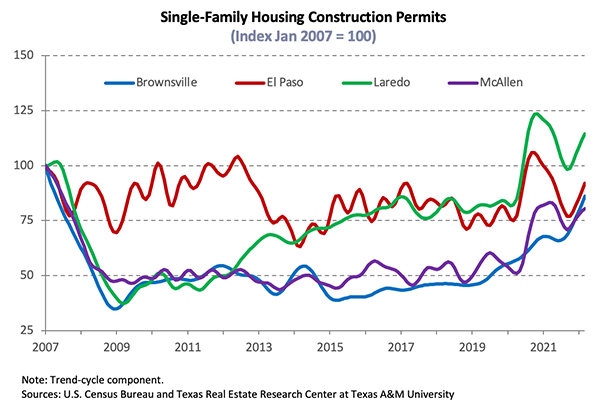Texas Border Economy
Joshua Roberson, Rajendra Patidar, and Weiling Yan (Jun 22, 2022)


“This article was originally posted by, Texas A&M University“
April 2022
Economic indicators in the border areas have reported mixed response for the month of April. The Texas border economy heavily depends on processing international trade and labor supply with Mexico, which can be valued at about $350 billion per year. The border economy was disrupted by the COVID-19 pandemic, but it was recovering quickly due to the government economic policies.
Payrolls in border Metropolitan Statistical Areas (MSAs) increased monthly. Construction activities decreased while trade activities improved as imports increased across the border. Problems like growing inflation, scarcity of raw materials, and supply chain issues greatly impacted the automotive and electronics sectors. Housing sales decreased for the first time this year, primarily due to rising inflation and higher mortgage rates. Rising median home prices and depleting inventories remained challenges for housing markets. In addition to COVID-19-related supply-chain disruptions, conflict in eastern Europe and Russia’s increased aggression in Ukraine disrupted the global economy and international trade. Rising inflation and interest rates can hamper future demand and overall border economy in the future.
Economy
The border economy continued its growth, as indicated by the Dallas Fed’s Business-Cycle Indexes. McAllen’s metric accelerated 8.7 percent on a seasonally adjusted annualized rate (SAAR) amid the largest payroll expansion among all border metros. El Paso’s index elevated by 2 percent while Brownsville and Laredo’s indexes increased by 4.9 and 7 percent, respectively. Pedestrian and personal-vehicle crossings were 70.3 and 42.6 percent higher, respectively, than a year ago (Figures 1 and 2), as the Department of Homeland Security revised its policy to allow noncitizens who are fully vaccinated and have appropriate documents to travel across borders during the last quarter of 2021.


Overall, border nonfarm employment added 1,500 jobs during April, resulting in 0.2 percent growth. Laredo added 400 positions while El Paso reported a loss of 900 jobs. Meanwhile, in the Rio Grande Valley, Brownsville and McAllen added 500 and 1,500 jobs, respectively. Trade, transportation, healthcare, education, and government contributed to the growth.
On the southern side of the border, Mexican manufacturing and maquiladora employment1increased by 8,190 jobs in March. Reynosa’s employment increased by 0.2 percent month over month (MOM), and Juarez’s increased by 1.8 percent MOM after adding 283 workers in the former and 5,536 in the latter during March. Meanwhile, maquiladora employment increased by 0.9 percent in Matamoros and by 1.2 percent in Nuevo Laredo MOM after adding 560 workers in the former and 355 workers in the latter. On the U.S. side of the border in April, motor vehicle manufacturing faced supply-chain issues in procuring semiconductor and increased security checks for vehicles entering Texas from Mexico, causing further logistic disruption.
The IHS Markit Mexico Manufacturing PMI for April indicated further deterioration in the overall confidence of Mexican manufacturing, primarily due to inflation concerns, raw material scarcity, and the war in Ukraine. The war in eastern Europe has led to an increase in energy, oil, and gasoline prices in border areas.
The averageApril unemployment rate fell to 6 percent along with the border metros. Joblessness fell to 4.8 percent for both El Paso and Laredo, while the metrics for the Rio Grande Valley fell to 7.7 percent in McAllen and 6.7 percent in Brownsville. Additionally, the labor force participation rate ticked up, while the number of weekly initial unemployment remained unchanged across border areas during April (Figure 3).

Fluctuations in the average private hourly earnings revealed positive real wage growth along the border except in Brownsville. Moreover, inflationary pressures prevented meaningful gains in purchasing power. Earnings in McAllen rose in real terms to an average nominal wage of $19.45 in April. Hourly wages in Brownsville ($16.95) trended downward, decreasing by 2.3 percent on average, while El Paso ($21.60) and Laredo ($19.45) reported increases of 2.71 percent and 2.1 percent, respectively, MOM. While baseline effects are mechanically weighed on YOY numbers, nominal wages are approaching pre-pandemic levels along the border.
Total construction values decelerated during April after increasing significantly the previous month. Changes in residential and nonresidential values varied across border areas. Nonresidential values for El Paso decreased while residential values for McAllen increased due to increases in single-family and multifamily construction. On the other side, the nonresidential values increased in Laredo as did warehouse construction. Meanwhile, Brownsville reported an increase in residential values and nonresidential construction values.
In the currency market, the peso per dollar exchange rate dropped to $20.09, but the inflation-adjusted rate2 decreased 3.5 percent YOY and 1.7 percent MOM, revealing gains for Mexican importers. Total trade values increased by 2.6 percent along the border areas in April. At the metropolitan level, total imports grew by 5.7 percent due to expanding trade activities in El Paso and Laredo, which rose 17.4 and 9.8 percent, respectively. Exports decreased 1.5 percent along the border with Laredo and McAllen both decreasing by 1.9 percent. Export values decelerated in El Paso as well, while Brownsville’s metric rebounded in the last two months. The border’s trade sector remains an integral component of the local economies. Ongoing supply-chain disruptions uniquely affected El Paso as its international commerce is largely dependent on products containing semiconductors.
Housing
Border housing sales inched down 2.9 percent in April after rising during the initial months of the year. In the Rio Grande Valley, McAllen posted a 1 percent decrease in housing sales, and Brownsville sales continued their decline from the previous month of 0.1 percentage points. Sales activity in Laredo increased slightly while El Paso’s metric fell by 2.3 percent. The sharp increase in mortgage rates is the primary reason for dwindling housing demand. The Federal Home Loan Mortgage Corporation’s 30-year, fixed-rate skyrocketed to 5 percent in April 2022, rising from a record low of 2.7 percent in January 2021.
Border metros issued 1,030 single-family housing construction permits, increasing 8.3 percent, due to a significant rise in new permits issued in McAllen (15.1 percent) and El Paso (12.9 percent). Brownsville had exponential growth in new permits issued during the first quarter, but they declined in April by 8.7 percent. They increased by 1.5 percent in Laredo. Meanwhile, private single-family construction values trended downward in the border area as the metric declined by 4.4 percent. Brownsville’s values rose by 5.1 percent, and McAllen’s values rose by 0.6 percent. El Paso’s and Laredo’s metrics posted declines in MOM growth in values after impressive growth the previous two months, which contributed to an overall decline in border construction values. While construction values corroborated positive levels of current supply-side activity, the dearth of permits suggests long-term supply challenges.
While a balanced housing market typically has a months of inventory (MOI) closer to six months, the MOI along the border remained much lower. Laredo’s growing sales activity and a downtick in new listings pushed the average MOI for April to 1.8 months. El Paso’s metric remained at a month. McAllen’s metric increased continuously to 2.1 months, while Brownsville’s inventory increased to 1.6 months in the first quarter. April’s increase in MOI during April indicates housing inventory is increasing.
Falling home sales increased the average number of days on market (DOM) along the border. However, the average metric was exceptionally lower in April than it was the previous year. El Paso’s DOM increased to 43 days, while McAllen’s rose to 55. Laredo’s DOM decreased to 37 days, while listings in Brownsville averaged nearly two months on the market.
Rising inflation contributed to median home price growth in the border metros. Tight inventories at the lower end of the market pushed activity into higher price cohorts. El Paso’s metric was at an all-time high of $238,359; Brownsville’s increased to $254,865. McAllen’s median home price increased to $223,983 after falling during the initial months of the year. Laredo’s metric increased from $214,065 to $233,607.
____________________
1 Mexican manufacturing and maquiladora employment data are generated by the Instituto Nacional de Estadística y Geografía. Its release typically lags the Texas Border Economy by one month.
2 The real peso per dollar exchange rate is inflation adjusted using the Texas Trade-Weighted Value of the Dollar. Its release typically lags the Texas Border Economy by one month.








